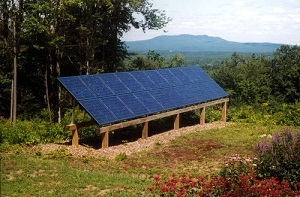Vermonters supporting solar over large-scale wind in recent protests
 The potential of 21 large-scale wind turbines along the verdant ridge-line of Lowell Mountain in Vermont has Vermonters—even fans of renewable energy—up in arms. On Aug. 24, protesters rallied at the Statehouse lawn in Montpelier to support the development of solar in Vermont over wind developments.
The potential of 21 large-scale wind turbines along the verdant ridge-line of Lowell Mountain in Vermont has Vermonters—even fans of renewable energy—up in arms. On Aug. 24, protesters rallied at the Statehouse lawn in Montpelier to support the development of solar in Vermont over wind developments.
On the same day, groups led by nonprofit Energize Vermont sent letters to Governor Peter Shumlin (D), asking him to drop his support for utility-scale wind, like the proposed 63-megawatt wind farm.
“We have 10 to 12 proposals for wind on our ridge lines,” said Energize Vermont spokesperson Luke Snelling. “Renewable energy is good. But there’s been this gold rush renewables [in Vermont].”
The impacts of utility-scale wind, which include permanent roads in sensitive areas and the visual impact to Vermont’s ridges could affect tourism, which is an important industry in the state.
Energize Vermont, as well as the protesters, support solar over wind, according to Snelling.
“Our maps show that the solar resources in Vermont are many times greater than the wind resources,” he said.
The organization is working to promote community solar installations and smaller installations.
“We promote energy that’s in harmony with the state,” he said. “We can do it in a way that’s good for communities and for residents.”
Energize Vermont has not proposed alternatives to the wind farm that would account for the entire 63 megawatts of capacity. But it is working to add more community solar in, according to Snelling.
“We proposed a group net-metered project in Rutland County. That model is one that is virtually impact free, supported by communities, solar based and repeatable throughout the state,” Snelling said.
The community solar project will be the first that the group has helped to organize and it takes advantage of recently enacted legislation, according to Snelling.
“Group net-metered projects can be attached to the grid at a cap of 500 kilowatts,” he said.
Under the law, the utility has to handle the generation capacity for the accountholder, and pay the owners 20 cents per kilowatt hour for the power generated by the system or credit it toward their electric bill.
For the Rutland project, which is being developed as kind of a repeatable model, people can buy a $1,200 share of the solar farm. After receiving incentives, the price falls to $800 per share, according to Snelling. Over its lifespan each share should generate $2,600 for the shareholder.
“One of the key strategies we’ll use is to sell to local businesses. So we can sell five shares rather than one-offs,” Snelling said. “We’re doing the first one in Rutland County and doing another in Wakefield. We’re pretty excited; it’s a different approach.”
Image courtesy of NREL.



